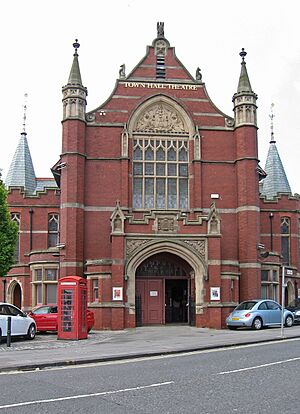West Hartlepool facts for kids
Quick facts for kids West Hartlepool |
|
|---|---|
 West Hartlepool Town Hall |
|
| Unitary authority |
|
| Ceremonial county | |
| Region | |
| Country | England |
| Sovereign state | United Kingdom |
| Police | Durham |
| Fire | County Durham and Darlington |
| Ambulance | North East |
| EU Parliament | North East England |
West Hartlepool was a town in County Durham, England. It was an earlier version of what we now call Hartlepool. The town grew a lot during the Victorian era. It got its name because it was located to the west of the older part of town, known as the Headland.
This town started in 1848. It was built to support the new railway and docks nearby. These docks were important for bringing in and sending out coal from the area. The railway network grew, connecting West Hartlepool to places like Leeds. Over time, the area developed further. This led to the creation of the larger town of Hartlepool in the 1960s.
Contents
History of West Hartlepool
The town of West Hartlepool was started by a man named Ralph Ward Jackson. He later became the boss of the Stockton and Hartlepool Railway in 1848.
The area, once called Newburn Raw, slowly became a busy place for shipping and trains. The West Hartlepool Harbour and Dock opened in 1847. It was about 8 acres in size. Five years later, in 1852, the Jackson Dock opened. This dock was even bigger, at 14 acres. A new railway line also opened, connecting West Hartlepool to big cities like Leeds, Manchester, and Liverpool.
Growing Industries and Population
A huge amount of timber trade began with countries around the Baltic Sea. This timber was needed for wooden supports in the nearby coal mines. Because of all this new work, the number of people living in the area grew very quickly.
Eight different shipbuilding yards were built in West Hartlepool. Many other businesses supported the shipbuilding industry. These included companies that made canvas, iron foundries, and places that made parts for ships like blocks and masts.
New streets were planned and built. Along these streets, shops and brick homes appeared. The town also got important services. These included paved roads, gas and electricity, sewers, a place to process meat, and a cemetery.
Important Buildings and Achievements
Ralph Ward Jackson also built a large church called Christ Church. The stone for the church came from the docks that were being dug. This church became a parish in 1854.
Another dock, Swainson Dock, opened in 1856. It was named after Ward Jackson's father-in-law. In 1878, the William Gray & Company shipyard in West Hartlepool became famous. It launched more ships by weight than any other shipyard in the world that year. They repeated this amazing achievement several times.
Changes in Town Status
West Hartlepool was once a small part of the Stranton parish. In 1887, it became its own municipal borough. This meant it had its own local government. Its main office was at the West Hartlepool Town Hall. On December 31, 1894, West Hartlepool became a separate civil parish. In 1902, it was made a county borough. This meant it was independent from the Durham County Council.
On April 1, 1967, a new county borough called Hartlepool was formed. This happened by joining West Hartlepool with the older town of Hartlepool. The separate parish of West Hartlepool was also ended and became part of Hartlepool. In 1961, West Hartlepool had a population of 77,035 people.
Sports in West Hartlepool
The town's Rugby Union football team started in 1881. It was formed by men who came to the area to build the railway and dig the docks. The team played until 1908. At that time, the "round ball game" (soccer) was becoming very popular.
Until 1968, the soccer team now known as Hartlepool United was called "Hartlepools United." The extra "s" showed that it represented both Hartlepool and West Hartlepool.
Notable People
- Margaret Green: An artist who was born in West Hartlepool.
- Lionel Tertis: A famous viola player. He asked many composers to write new music for the viola. He was also born in West Hartlepool.
Gallery





